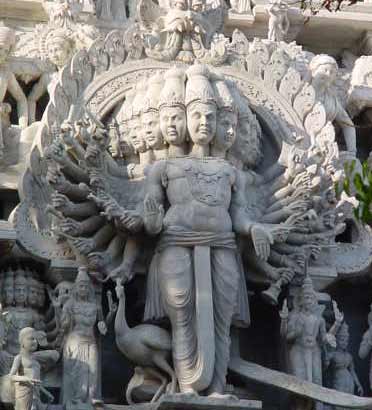 |
THIRUCHANDUR
“O son of Parameshwara!
O merciful Lord,
When you have twelve large eyes stretching to your ears,
What can you lose by casting a side glance at me for a minute?”
Subramanya Bhujangam
By Adi Shankaracharya.
“O son of Parameshwara!
O merciful Lord,
When you have twelve large eyes stretching to your ears,
What can you lose by casting a side glance at me for a minute?”
Subramanya Bhujangam
By Adi Shankaracharya.
During the recent tsunami in November 2004, which lashed the southern coast of India, a miracle occurred in this coastal temple of Thiruchandur dedicated to Lord Muruga. All those who were there were witnesses to the fact that the ocean which lashed forward with vengeance as if to devour the land suddenly stopped short at the rocky base of the shrine. The huge waves, rising high like mountains slowly but surely receded like chastised hunting dogs and sank back into the waters from which they had come. On either side trees and houses were swept away like toys into the hungry waters. This happened even though the sea level here is higher than the ground level of the sanctum sanctorum.
Normally you find that Muruga temples are placed either on top of hills or on sea shores. Thiruchandur temple is indeed placed on a beautiful spot right on the coast of the Gulf of Mannar. The sea girdles the temple on the east and north and the waves lash the rocks on these two sides. In the morning the sun rises from the sea right in front of the temple and makes its obeisance to the Lord. The sanctum sanctorum is said to be carved out of rock and is inside a cave. The temple was made by the divine architect Mayan at Kartikeya’s orders for he wanted to worship his father. In fact as you go inside from the seashore into the temple you realise that actually it has been carved out of a hillock. Thus the temple has great architectural beauty. His form here is that of Balasubramanya (boy Subramania) with four hands and one face. Here he is a brahmachari (celibate). Devayani was Indra’s daughter and he gave her in marriage to Kartikeya after he defeated Surapadma.
There is a legend connected with the idol of Shanmukha which is the utsava murti which is carried in procession round the temple. In the year 1648 the Dutch invaded the temple and carried away the idol. Very soon a dreadful storm broke out and the frightened sailors suspected that the idol had something to do with it and threw it overboard. The theft was reported to the Nayak ruler who made a similar idol out of panchaloka (five types of metals). Meanwhile the Lord appeared to him in a dream and told that he would find the original at the spot where a lime was floating in the sea. The exact spot was pointed out to him by the Garuda, the royal eagle vehicle of Vishnu which was seen to be slowly circumambulating the place. Thus the original idol was found and reinstated in the temple.
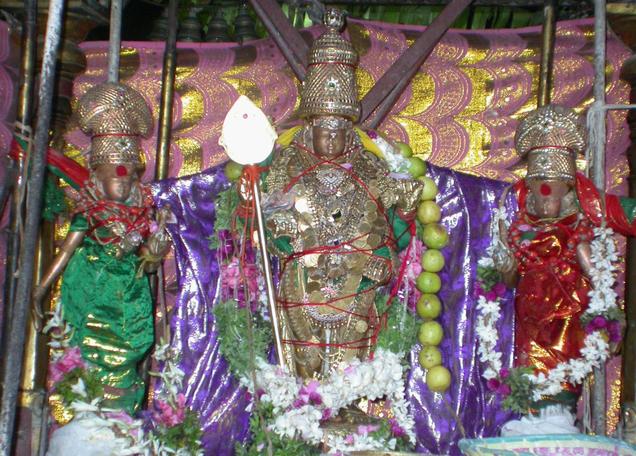
Shanmukha
The Raja Gopuram (temple tower) on the western side is a striking piece of architecture. It is one hundred and thirty seven feet high and has nine storeys. It is said that three hundred years ago the reigning pontiff of the Thirvadurai Mutt was commanded in a dream to build a gopuram for the Lord. He had no money to even contemplate such a task but he decided to start since it was the Lord’s wish. When the time came to pay the labourers, he gave them a pinch of the Lord’s vibhuti or ashes as he had been commanded to do. The ashes turned to gold coins as the labourers passed by the huge Vinayaka shrine. However after completing the sixth storey, the miracle ceased and again he was desperate as to how he could complete his task. Again the Lord sent another patron who gave him a sack of salt. On reaching Tiruchandur the salt turned into gold and that was sufficient money to complete his task.
The avatara (incarnation) of Muruga was taken in order to subdue the three ferocious brothers known as Surapadma, Simhamukha and Taraka. They had subdued Indra and taken over the suzerainty of the heavens and the gods were reduced to the position of slaves. The desperate gods begged Lord Shiva for assistance. He took on a form with six faces. A spark like a meteor shot out of each face. The terrified gods did not know how to handle the situation and begged Vayu, the wind god and Agni, the fire god to carry the sparks and deposit them in the River Ganga. She carried the sparks to a lake known as Sharavana which was filled with “shara” reeds. When the sparks reached the lake they changed into six incredibly beautiful babies. The six stars known as Krittikas took on human forms and came to give suck to the six divine infants.
Kṛttikā
The gods had been closely following the progress of the sparks and reported the whole miraculous tale to Shiva and Parvati. They went immediately to the spot and Parvati was delighted to see the babies and gathered them all up in her arms at which they became one single baby with six faces and twelve hands.
The birth of Skanda is actually the story of creation. Before creation the Supreme, Brahman alone existed, filling etheric space. From there the light passed through the air (Vayu), to fire (Agni), and dropped into the waters and was deposited on the banks of the lake into the earth. Thus the five elements of ether, air, fire, water and earth combined in order to nurture the tejas or seed of Shiva. He was born like all of us out of the union of Shiva and Parvati – the Supreme Person and Prakriti or Nature. There is an irrevocable connection between these two. Creation takes place only because of this union.
Indra and the gods now came and claimed the child and insisted that he was born to be their general and should lead their army to victory. They insisted that he should be crowned as their general. Shiva and Parvati reluctantly agreed and Kartikeya was crowned as general and led the gods.
Thiruchandur is the place where Lord Muruga set up his camp in order to subdue the great asura- Surapadma who had set up his fortress in the middle of the ocean off the place known as Veeramahendrapuram near Thiruchandur.
The Lord plunged into the battle and fought the demon hoards for six days, on land, on the sea and in the air. All the asuras except Surapadma perished. The latter rose up in the form of a mango tree in the middle of the ocean. Kartikeya took Indra as his charger and split the tree into two. The asura emerged out of the tree in the twin forms of a cock and a peacock and continued to fight. Muruga was filled with admiration for his courageous opponent and forgave him and gave him the Vishwaroopa darshan (vision of the cosmic form) before slaying him. He made the peacock his permanent vehicle and placed the rooster on his banner. Thus the asura stays forever with the Lord in all his abodes.
The festival known as Skanda shasti is celebrated in all Muruga temples in order to commemorate this battle. It lasts for six days and on the final day the epic battle is re-enacted.
After he defeated Surapadma he installed the atma linga known as the Jagannatha linga in the temple designed for him by the divine architect, Mayan. This rock temple of Tiruchandur is the one made by Mayan. After worshipping his father, the Lord turned to the east in order to give darshan to his devotees. Pujas are performed first to the Shiva Lingam before being done to the idol of Subramanya.
The next evening I could witness the function when the Lord was brought out in a golden palanquin weighing 2,000 kilograms carried by eight people to the chanting of the Kumara Suktam from the Yajur Veda. At this time everyone could see him so the crowd were enormous. This offering is only done twice a year, in the month of Chaitram and Vasantham. The palanquin is taken eleven times round the main Mandapam known as the Vasantha Mandapam and then the Lord is taken out and placed on the mandapam (platform) which is surrounded by water in order to keep him cool. In fact the pedestal rests in water. All along the way the local ladies sing a special song known only to them. The words of this ancient song have been passed down through the generations. I considered myself very fortunate to have been present at that time of the year even though it meant battling with the crowds. I was always lagging behind since I hated to be jostled by the crowd but somehow the priest would spot me and drag me to the front and insist that I take part in all the aratis(waving of lights) etc which were going on.
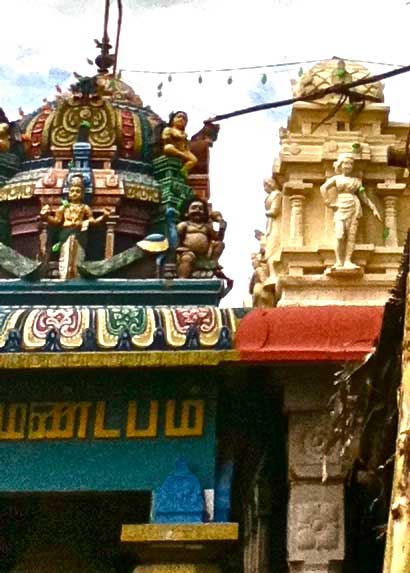
Mt eyes filled with tears to see the faith and devotion of the villagers who came and camped for days on the beach. They carried their own utensils and food and sat on the ground and made a fire and prepared their meals without any fuss and bother. It was really an incredible sight. The vibhuti or ashes which is given as prasad is said to have miraculous powers. Many stories have been reported of people suffering from skin diseases who have been completely cured by the application of the ashes.
The power in all temples is intensified by the feet of the saints who have visited the place. Many Saivite saints have visited this temple and sung its glories. The great poem Thirumurgatruppadai by Nakkirar and other great poems by Arunagirinathar were composed here. Adi Shankaracharya had also visited this temple and praised the Lord in his famous Subramanya Bhujangam from which two verses have been quoted at the beginning and end of this article. He is supposed to have been cured of his illness by using the vibhuti of the Lord.
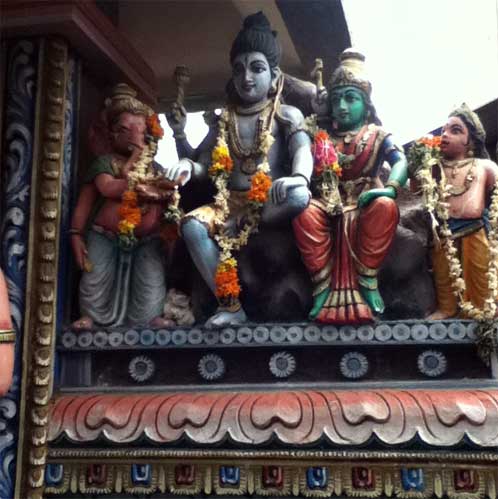
Another miraculous feature of this place is the Nazhi Kinaru. This is a well which is found close to the temple. It is a 14 square foot well with a small 1 square foot well inside. The big well has brackish water but the small well has sweet water. It is said that Lord Muruga struck his vel (lance) into the ground in order to get water for his thirsty soldiers after the battle.
From here I went by taxi to Madurai. The pujari and his entire family accompanied me, ostensibly in order to escort me but I suspected that he had some business in Madurai and the rest of his family came for the joy ride! I was of course squashed between his wife and the door!
In Madurai I realised that the Lord had played another of his lilas on me. Without my knowledge I was taken to two more of his divine abodes. I did not even realise that I was being taken to these famous places until I returned. In the playing of their leelas I find that Muruga and Krishna have a lot in common. They both love to play pranks. Thiruparakundram was only ten kilometres south of Madurai and Palamutirsolai was another ten kilometres north of Madurai. Both these are part of the six abodes. A truly kind soul from the Akshaya Trust took on the self appointed task of taking me to these two wonderful temples.
Thiruparakundram is a wonderful place. Indra, the king of the gods was so grateful to Muruga for having helped him defeat Surapadma that he gave his daughter Devayani in marriage to him. This was the place where the marriage took place. As if to please my desire for a quiet darshan, this temple was quite deserted. One has to climb up some steps to reach the sanctorum. The idol was so close I could have leaned forward and touched it. He was dressed as a bridegroom. The pujari took great pains to make our darshan truly memorable and allowed us to stay in front as long as we liked. I would have been happy to sit and meditate here but we were pressed for time. The two great Saivite saints of India, Jnana Sambandar and Sudaramurti had visited this place and written about it.
After this I was taken to Palamutirsolai. This is on top of a hill and is set amidst most peaceful and beautiful surroundings. Here He is flanked by both Valli and Devayani. We had to walk through a lovely forest to get to the temple. Right on top of the hill is the Noopura Ganga which is a small perennial cascade. There is a temple here dedicated to Rakkayi Amman. As if to commemorate my visit to the last of the six abodes of Muruga, we reached the temple for the most important puja of the day before it closes for the afternoon. There were not many people so we sat right in front of the sanctorum and had the pleasure of having the sanctified water being sprinkled on us when the doors opened. I felt that He was trying to make up to me for having taken me first through such crowds and then giving me darshan in such idyllic surroundings. Later on in the month I might mention that I was also taken to Palni, thus completing four of the famous six abodes of Lord Muruga. Let me mention that when I started the pilgrimage I had no idea of going anywhere but to Thiruchandur and Madurai and it was only at the end that I found that I had been showered with such abundant grace!
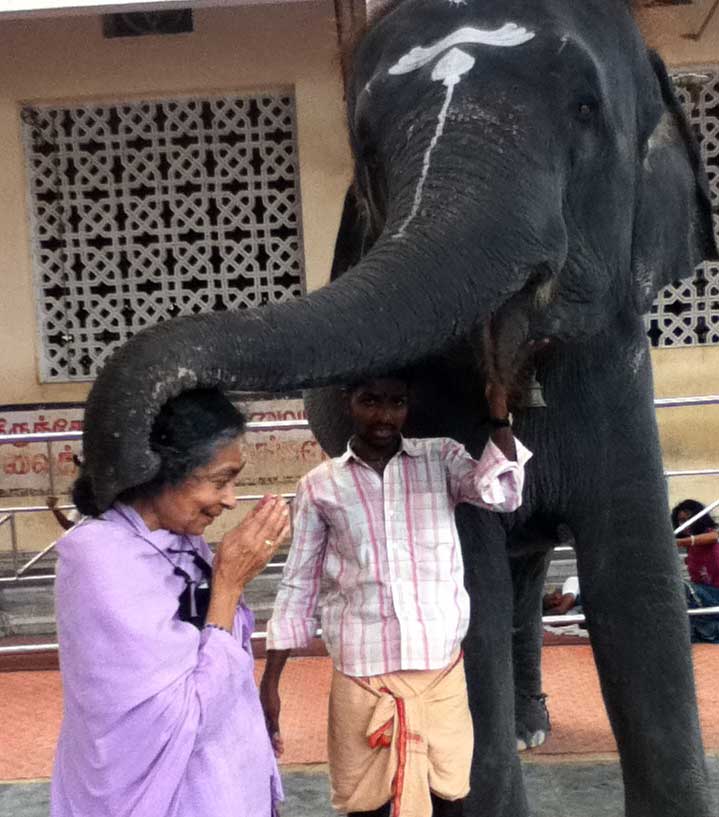
“O son of Shiva!
Your six smiling lotus faces,
Shine like a group of swans,
Your eyes glance sideways, moving like a row of bees,
Over your red lips overflowing with nectar.”
Subramanya Bhujangam,
Adi Shankaracharya.
Hari Aum Tat Sat.
About Vanamali |
Satsang and Meditation |
Puja |
Seva |
Miracle at Vanamali |
Sunildas |
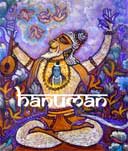 |
Bhagavad Gita |
Wild flower Cards |
Gajja |
Links |
Reason for Rebirth |
Vanamali Love Songs |
<>
<>